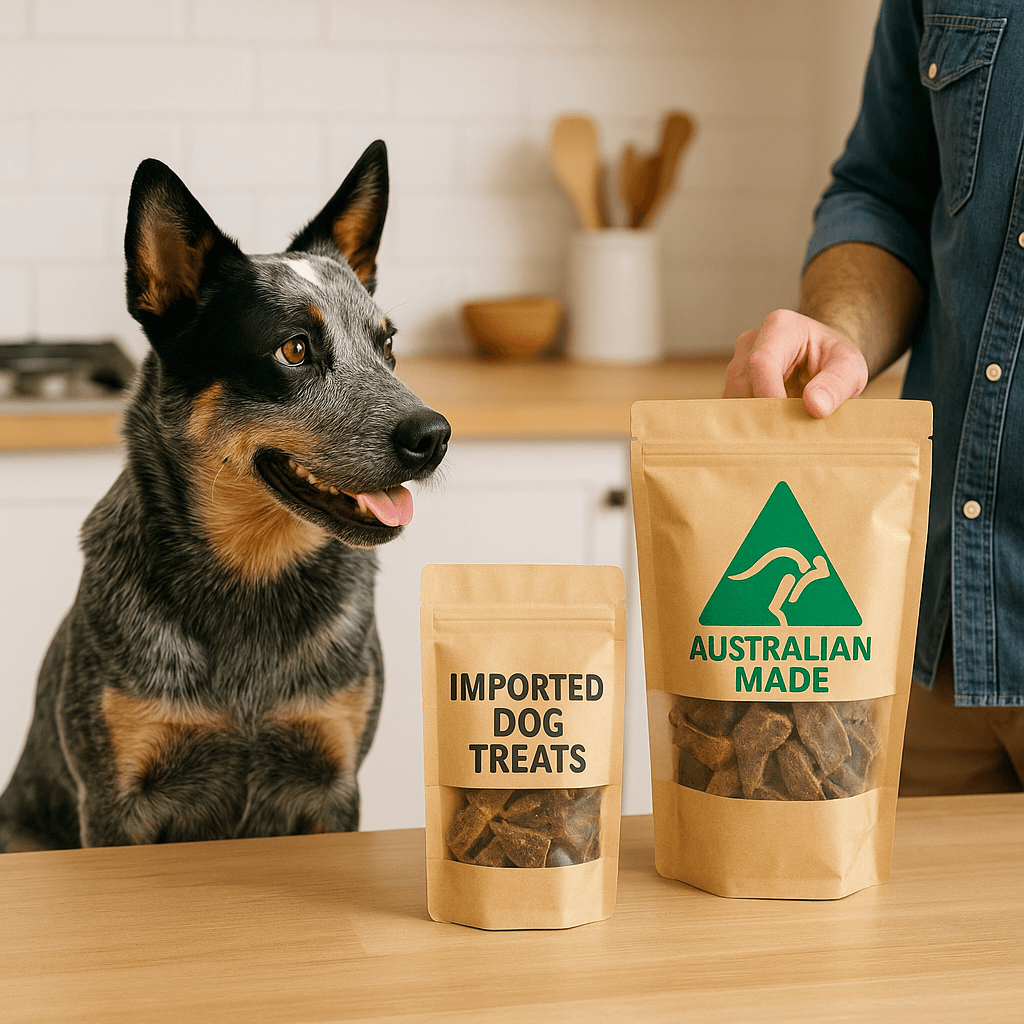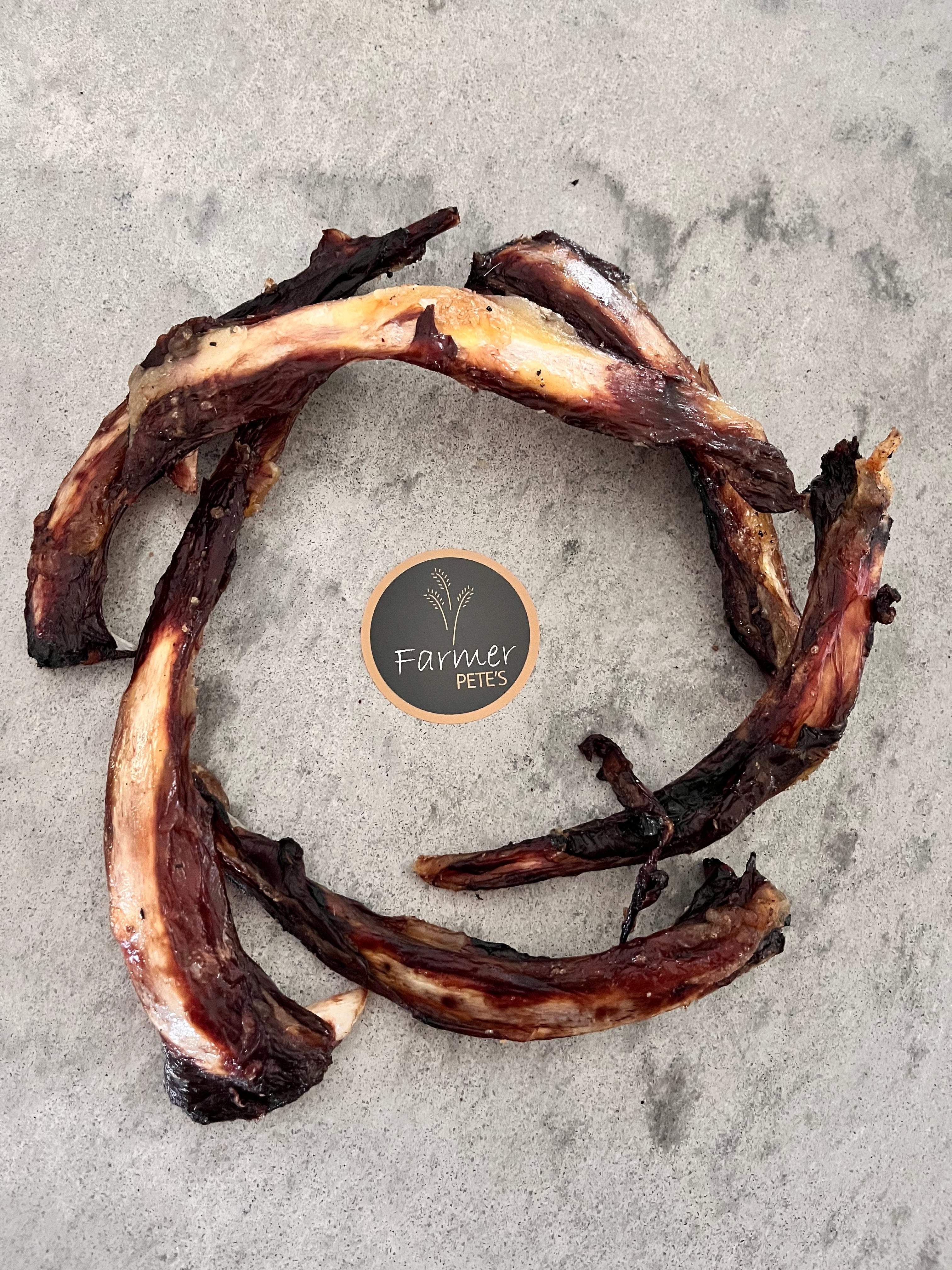We all do it, and it makes us happy. Give treats to our pets that is!
Giving treats to your dog can be a fun and rewarding experience, but it's important to do so in a safe and controlled manner. You may not think so, but there’s a right way and a wrong way to give a dog treats.
Giving a dog a treat, the wrong way could not only leave you with nine fingers, but you could also be reinforcing bad behaviour. A few technique changes could make the world of difference that ends up with positive results.

Here Are A Few Tips When Giving Out Pet Treats
When giving a treat lean down to the dog’s height so all 4 paws are on the ground. Holding a treat up high encourages pets to jump up to get it, which becomes unsafe, for both the dog and the person giving the treat, also it can reinforce the jumping for something good, making it hard to stop your dog from jumping up to greet people.
If you feed a little too low, your dog may think you are asking her to lie down. If you feed too close and you’re invading her space and she may back away from you. If you feed too far away or pull your hand back as she reaches for it, you are teaching to get grab for treats as she tries to secure it.
Waving treats around creates excitement, chasing, and jumping. The dog may quickly snap his teeth to get the treat; in doing so he may also bite your finger. Ouch!
Recognising that treats make a great reward but need to be used with care and caution is paramount. Being careful and mindful when giving pet treats will also help prevent your pet creating bad behaviours or hurting someone.
So, How Should You Give Your Pet Treats?
Put the treat on a flat hand or in between your thumb and forefinger and offer the treat a 1.5 – 3 cm from the dog’s mouth, right at nose level, and keep your hand still as she takes it from your fingers. This way the dog can take the treat easily, without jumping or charging you down to get it.
However, it’s important to remember that each dog is an individual, and you may want to experiment a little with your own dog to determine where the best treat-feeding spot is for her.

How Many Treats For Your Dog Is Too Many?
We all just love seeing our pet get soooo excited to receive a treat. It makes us feel loved and gives us the warm and fuzzies, but how many pet treats are too many?
Without a doubt, pet treats can play a useful role in positive reinforcement training but many of us (pet professionals and pet owners alike) tend to give treats as an expression of love or affection.
Certainly, treats can be used to reinforce good behaviour, they can be used during training sessions and as a distraction cue. For example, when a dog is anxious. Even when using treats at an appropriate time, it’s essential to consider a few things:
- When is the best time to give out treats to your dog?
- What type of treat is best?
- Are they healthy for your dog?
- What pet treats to give and how many?
Choose healthy pet treats and make sure they’re suitable for pets. Farmer Pete’s takes away the guess work here as ALL of our treats are healthy and suitable for your pet. While we humans might consider chocolate a treat, it’s not at all suitable for pets and may even make them sick.
Chew’s, make for great treats, as dogs love them but they’re beneficial for the health of their teeth too. Fantastic!
The recommendation is that pet treats used during training should be no more than 10% of a dog’s daily food intake. Below is the recommended guide for Calories from Treats Per Dog Size and Daily Calorie Intake from Teats for Different Dog Sizes;
Small (4kg) dog = no more than 18 calories/day from treats
Medium (15kg) dog = no more than 51 calories/day from treats
Large (25kg) dog = no more than 81 calories/day from treats
Extra-large (35kg) dog = no more than 110 calories/day from treats
| Dog Size | Calories from Treats (per day) |
|---|---|
| Small (4kg) | 18 |
| Medium (15kg) | 51 |
| Large (25kg) | 81 |
| Extra-large (35kg) | 110 |

The problem is, aside from the fact it can be difficult to work out your pet’s recommended total calorie intake for the day, some pet treats don’t say how many calories they contain. In this case, it might just come down to using common sense and keeping a close eye on the number of treats you’re handing out. All Farmer Pete’s treats have a nutritional analysis available on the website.
Using Pet Treats Effectively To Last Longer (And Not Over Do It)
There are myriad reasons why it might be useful or beneficial to give a dog or cat a pet treat. However, there are also times when a treat might not be the best option.
It is important to recognise how and when to use treats. The following guidelines are here to help:
Choose High-Quality Treats:
Just like with your own food choices, it's important to select treats that are made from wholesome ingredients and are appropriate for your dog's size and dietary needs. Look for treats with real meat, poultry, or fish as the main ingredient. Avoid treats that contain artificial colours, flavours, additives and preservatives, and fillers as these can be harmful to your dog's health.
Portion Control:
Treats should make up only a small portion of your dog's daily caloric intake. Overindulging in treats can lead to weight gain and related health issues, such as joint problems and diabetes. It is wise to consult your veterinarian to determine the appropriate number of treats for your dog based on their age, size, activity level, and overall health.
Use Treats for Training:
Treats are fantastic rewards for training sessions because they motivate your dog to learn new behaviours and commands. Use small, soft treats that your dog can quickly consume without getting distracted. Break treats into smaller pieces for prolonged training sessions. Choose treats that are particularly enticing and easily consumable. For example, small pieces of Farmer Pete’s Dehydrated Chicken Bites or Beef Liver work well for training purposes.
Practice Basic Obedience:
Consistency is key in dog training. Reward your dog with treats immediately after they successfully perform a command. This reinforcement strengthens their understanding of the desired behaviour and encourages them to repeat it. Use treats to reward your dog for following basic commands like sit, stay, come, and lie down.
Healthy Options:
Incorporating variety into your dog's treat repertoire can provide additional nutrients and dietary fiber. Dehydrated lean meats like chicken, Kangaroo, Crocodile, and Flake can also make for tasty and healthy treats. Make sure the treats are safe and suitable for your dog's digestive system.
Avoid Harmful Foods:
Some human foods are toxic to dogs and can cause severe health problems. Keep chocolate, grapes, raisins, onions, garlic, alcohol, and products containing the artificial sweetener xylitol far away from your dog. Educate yourself on other potential hazards, and when in doubt, consult your vet. These substances can be harmful or even fatal to dogs.
Mind the Calories:
Look for low-calorie treats, Balance is crucial when giving treats to your dog. Be mindful of the calorie content of treats. High-calorie treats can quickly add up and contribute to weight gain. If your dog is on a weight management plan, consider using low-calorie treats or breaking larger treats into smaller pieces. or adjust your dog's meals to accommodate the extra calories from treats.
Variety and Rotation:
Just like humans, dogs can get bored with the same treats over time and can appreciate variety in their diet. Rotate between a variety of treats to keep your dog excited and engaged. This can also help prevent them from developing strong preferences that might make training challenging. Farmer Pete’s has an extensive and varied range for all types of dogs.
Monitor Allergies:
If your dog has allergies or sensitivities, read treat labels carefully to ensure they don't contain any problematic ingredients. Common allergens include wheat, soy, corn, and certain protein sources. Look out for treats that are specifically labelled as hypoallergenic if needed, such as Farmer Pete’s Crocodile Meat and Crocodile Feet
Chew Toys and Dental Health:
Dental health is crucial for your dog's overall well-being. Consider using teats designed as dental chews that help reduce tartar and plaque build-up. Always supervise your dog while they're chewing to prevent any choking hazards or complications.
Handfeeding:
Hand-feeding treats allows you to establish a deeper connection with your dog. It also provides an opportunity for your dog to learn patience and self-control as they wait for the treat. This technique can be especially helpful if your dog is overly excited or prone to gulping down treats.
Moderation is Key:
Ultimately, treats should complement your dog's balanced diet, not replace it. While treats can be a wonderful way to show affection and reinforce positive behaviour, too many treats can lead to obesity and health problems, they should be given in moderation to maintain your dog's health and well-being.
Conclusion On Giving Treats To Your Dog
By following these guidelines, you can create a positive and enjoyable treat-giving experience for both you and your dog while promoting their health and happiness. Remember each dog is unique and your dog's individual needs, preferences, dietary needs, and any health conditions they may have should always guide your decisions when it comes to treating them.
Consulting with your veterinarian can provide tailored advice for treating your specific furry friend.



